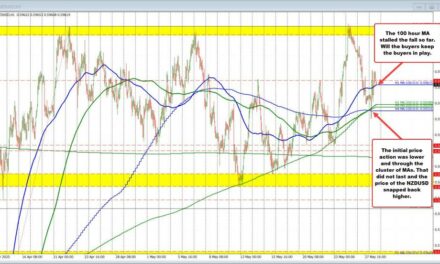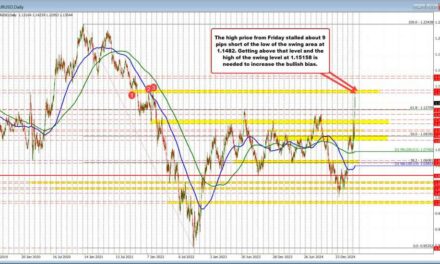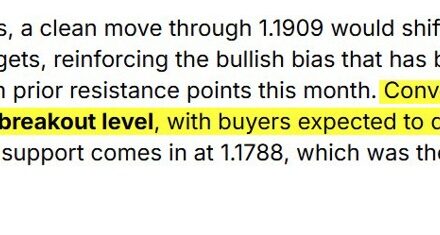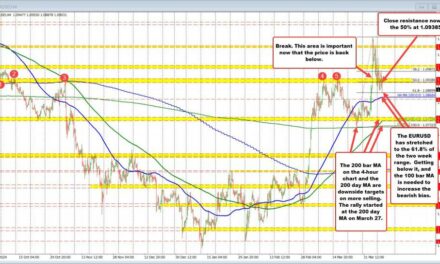The U.S. dollar moved higher following stronger-than-expected ADP employment and GDP data.
Q2 GDP rose at a 3.0% annualized pace, boosted largely by favorable shifts in trade and inventories. In contrast to Q1—when a surge in imports widened the trade deficit and dragged growth—Q2 saw a decline in imports, which helped lift the headline figure. However, final sales to private domestic purchasers rose just 1.2%, marking the weakest reading since Q4 2022 and highlighting softer underlying demand.
ADP private payrolls rose 104K vs. 75K expected, while the prior month was revised higher to -23K from -33K. While encouraging, it’s worth noting that ADP figures have not closely tracked the BLS nonfarm payrolls, limiting their predictive power.
Up next is the BOC, where the expectations are for no change in policy.
Looking at the US dollar and the technicals driving some of the major currency pairs including the USDCAD, the dollar has moved higher:
- EURUSD: The EURUSD fell below a swing area near 1.1525 (higher USD), and continued the fall through another swing area near 1.1486 and 1.1495. The low price moved to 1.1460 so far. The next target comes against the 50% midpoint of the move up from the May low to the July high. That level comes in at 1.1447. That level also corresponds with a swing level going back to June 10, June 19 and June 23 (see red numbered circles on the chart below) increasing the levels of importance from a technical perspective. A move below that level – and staying below – would have traders targeting the 100-day moving average down at 1.1389.. The close risk for traders is at the high of the swing area near 1.1500.
- USDJPY: The USDJPY has moved to new highs and moved above a swing area between 148.56 and 148.724 (now a close risk level for traders). The next key target comes against the 50% midpoint of the move down from the 2025 high to the 2025 low. That midpoint level comes in at 149.036. The high price off of the low extended above that midpoint level on July 16 to 149.18 before rotating lower. The high price on July 17 peaked at 149.08, just above that midpoint level, before once again rotating lower. Getting and staying above 50% is needed to give the buyers another boost with the 200-day moving average at 149.532 as the next key target.
Coming up at 9:45 AM, the Bank of Canada (BoC) will announce or interest rate decision. They are expected to keep their policy rate unchanged at 2.75%. Uncertainty surrounding U.S. trade tariffs and their potential impact on the Canadian economy will likely be a theme. The expectations are there will be any new deal signed before August 1.
The rate at 2.75 sits at the midpoint of the BoC’s neutral range (2.25–3.25%), allowing flexibility in either direction depending on economic developments.
The markets are pricing in a 56% chance of one more rate cut by year-end, further easing is unlikely unless trade tensions escalate and materially weaken growth. Although core inflation remains elevated near the upper end of the BoC’s 1–3% target range, labor market strength and recent data on consumer spending and business sentiment suggest resilience.
However, risks remain tilted to the downside due to ongoing trade uncertainties. Canada faces a 25% blanket tariff from the U.S. on non-USMCA-compliant goods, with the real threat of that rising to 35% if no deal is reached by August 1 which is expected.
Canadian Prime Minister Carney speaking on the tough trade talks with the US, said :
- Trade talks with US are at an intense phase.
- Any trade deal with US must be on fair terms for Canada.
- Reiterates that a US trade deal without any tariffs is not likely.
- There’s a question as to how much those tariffs would be.
- Asked about Trump’s comment about difficulty of negotiations a deal with Canada, yes we are difficult but we are fighting for Canada.
Governor Macklem reiterated that future rate cuts would only be considered if the broader economy weakens materially. The recent moderation in inflation, coupled with encouraging labor and employment data, supports the BoC’s decision to maintain current rates for now while closely monitoring developments tied to U.S. trade actions.
Technically, the USDCAD has been running to the upside since bottoming against a trend line last week at session lows. The price now running away from the 50% midpoint at 1.3777. The price is also extended above the high price from June at 1.37969. The price today has reached 1.3812 so far. The next key target on the hourly chart does not come until 1.38335 where the 61.8% retracement of the move down from the May high is located (see chart below).
Just before that level is the 100 day moving average at 1.38277. The price has not been above the 100 day moving average since early April.
This article was written by Greg Michalowski at investinglive.com.
Source link







